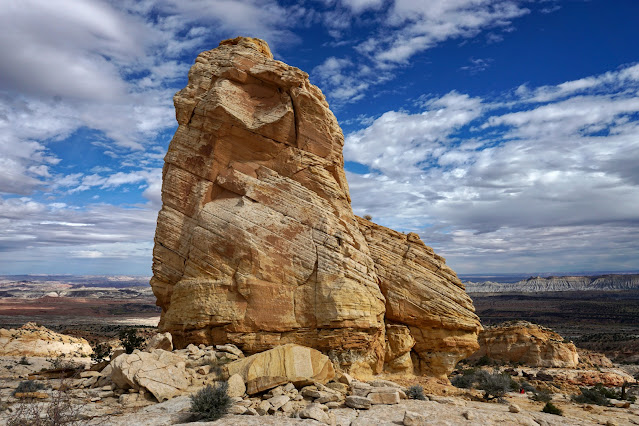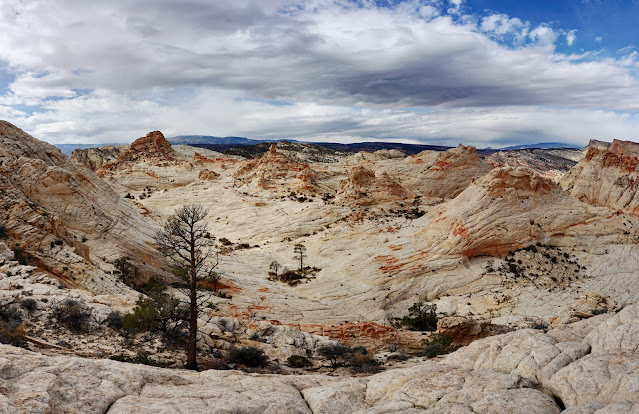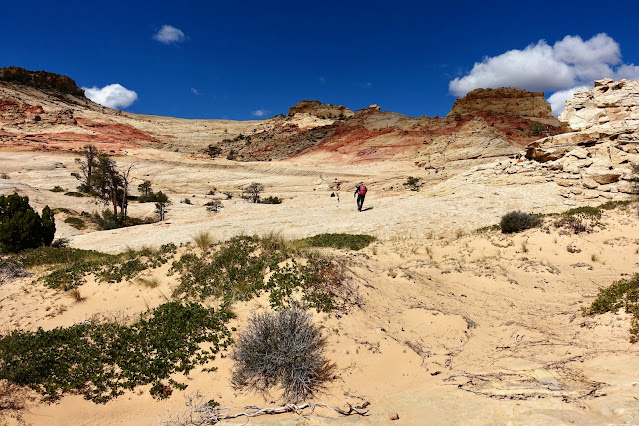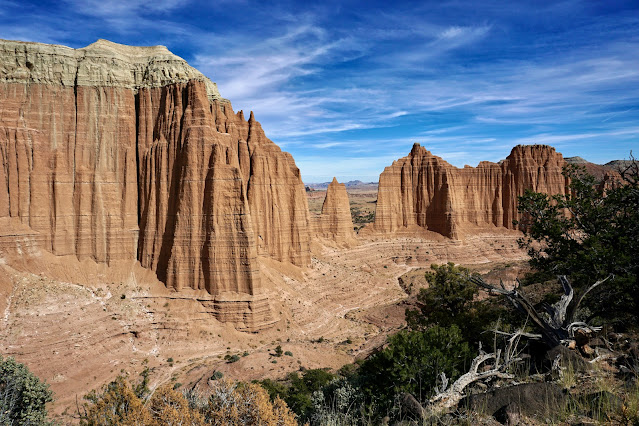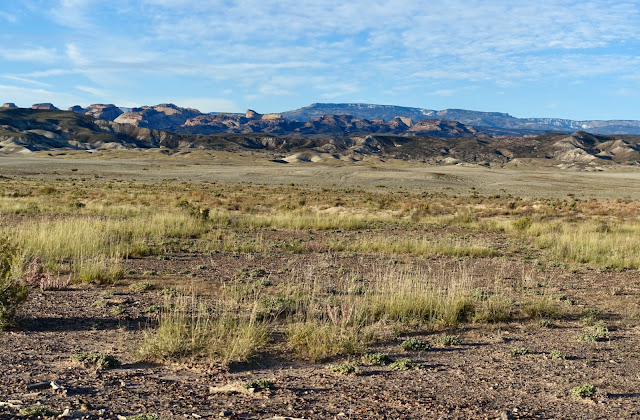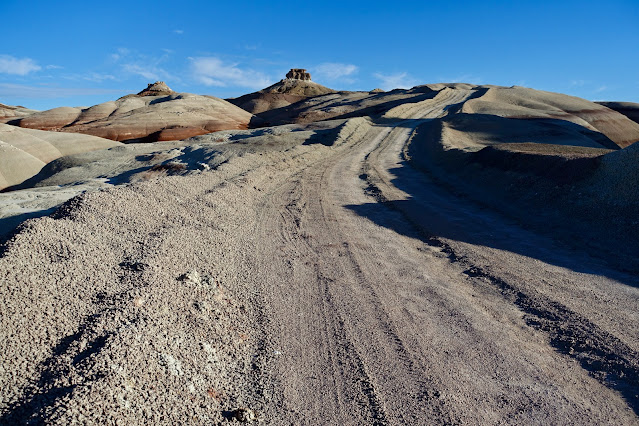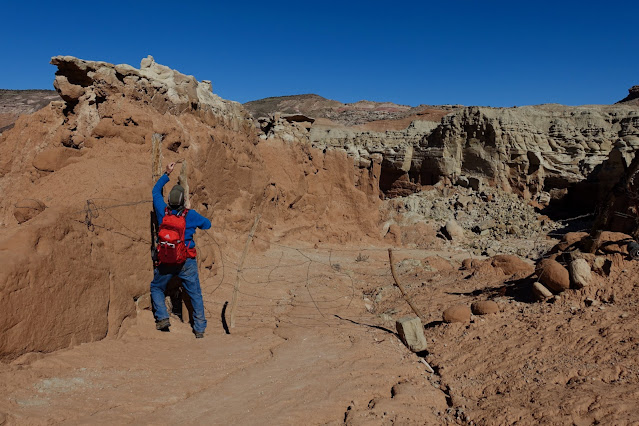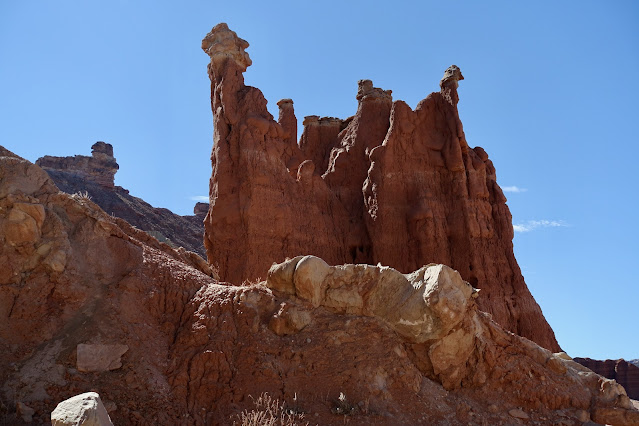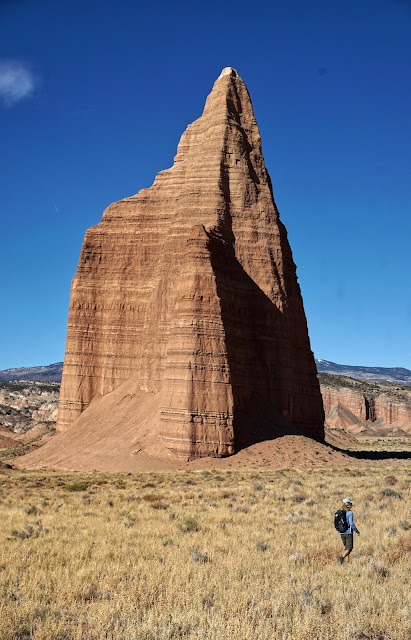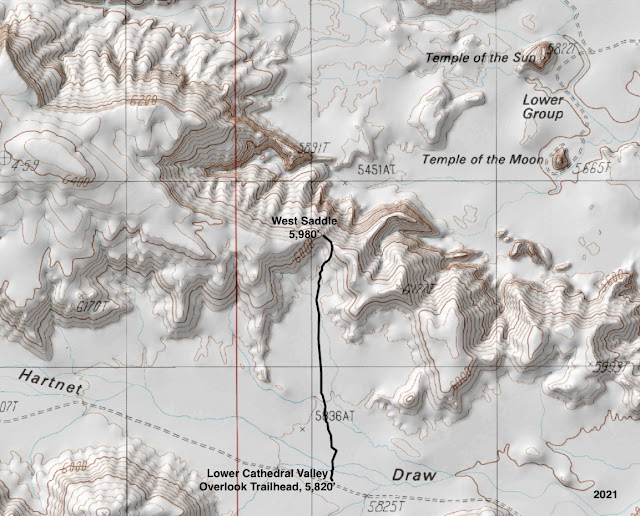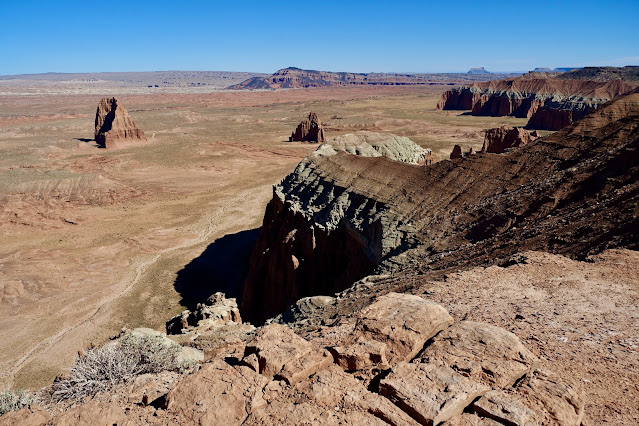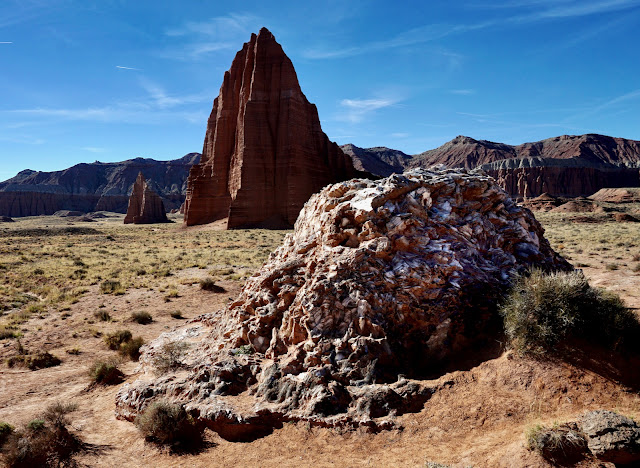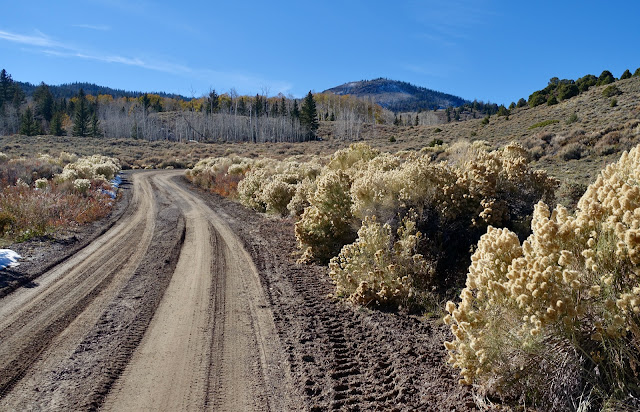Travel: From the Visitor Center and UT-24, drive south on Scenic Drive. Pass by the campground, the Grand Wash turnoff, and go over the Slickrock Divide. In eight miles, Pleasant Creek Road branches to the right and the paved road transitions to graded dirt. Upon entering Capitol Gorge the road is squeezed between constricted towering walls. Park in a large lot at 10.2 miles. During moderately busy days the lot fills by mid-morning. Pit toilet and picnic ramada, but no water.
Fruita Campground: This idyllic, shady campground is adjacent to the Fremont River, tucked amongst historic fruit orchards. In 2018, the campground initiated a reservation system. The 71 sites are first-come, first-serve November through February. There are bathrooms, fire grates, picnic tables, and water. Park facilities are open year-round. See the park website for current fee information and a link to the camping reservation system.
Distance and Elevation Gain: 11.3 miles as described; 1,850 feet of climbing
Total Time: 6:00 to 8:00
Difficulty: Primarily off-trail; navigation challenging; Class 2; flash flood hazard in Capitol Gorge; carry all the water you will need and hike on a cool day.
Maps: Golden Throne, UT 7.5' USGS; Hiking Map and Guide: Capitol Reef National Park
Fruita Campground: This idyllic, shady campground is adjacent to the Fremont River, tucked amongst historic fruit orchards. In 2018, the campground initiated a reservation system. The 71 sites are first-come, first-serve November through February. There are bathrooms, fire grates, picnic tables, and water. Park facilities are open year-round. See the park website for current fee information and a link to the camping reservation system.
Distance and Elevation Gain: 11.3 miles as described; 1,850 feet of climbing
Total Time: 6:00 to 8:00
Difficulty: Primarily off-trail; navigation challenging; Class 2; flash flood hazard in Capitol Gorge; carry all the water you will need and hike on a cool day.
Maps: Golden Throne, UT 7.5' USGS; Hiking Map and Guide: Capitol Reef National Park
Reference: Capitol Reef National Park: The Complete Hiking and Touring Guide, by Rick Stinchfield. Excellent introduction to hikes, drives, and natural history of the park. Purchase at the Visitor Center.
Latest Date Hiked: October 23, 2021
Quote: We met in these lost, rugged landscapes and slipped in as if we belonged there, hoping to be swallowed.
Latest Date Hiked: October 23, 2021
Quote: We met in these lost, rugged landscapes and slipped in as if we belonged there, hoping to be swallowed.
Craig Childs
Steps up and away from Capitol Gorge is a scenic ridge overlooking a stone wilderness. The earth pitches vertically to create buttresses (Golden Throne is image-center), pulses through hidden canyons, and rears up into folded fins and geodesic polyhedrons. (Thomas Holt Ward, photo)
Route: Walk northeast downcanyon in Capitol Gorge until the walls begin to dissipate. Bear southwest on a subtle trail and when it disappears, continue southwest on a broad ridge. Upon reaching the first Waterpocket Canyon overlook at 6,020 feet, bear south on the rim. Locate a safe drop into the south tributary at about 6,220 feet. Free range over Navajo Sandstone to the monolith overlooking Waterpocket Canyon.
Capitol Gorge
The Golden Throne and Capitol Gorge trails leave from different locations in a shared parking lot, elevation 5,420 feet. Walk through the picnic ramada and locate a trail heading down the canyon skimming along the north wall. The grinding determination of water has pushed the sandstone walls towering roughly 800 feet overhead into a wide stance.A word about mileages: GPS units can get glitchy in deep canyons so your readings may vary from those posted here. Use landmarks as your guide.
Visit a petroglyph panel at 0.2 mile attributed to the Fremont Culture (300-1300 Common Era). The images have grown faint from weathering but a sunburst image stands out. The anthropomorphic figures have trapezoidal-shaped bodies elaborately decorated with horned headdresses, ear bobs, and necklaces.
In another tenth of a mile, the names of six surveyors (see Rick Stinchfield, referenced above), are deeply etched on a varnished slab fifty feet up the south wall. How did they make that happen?
The trail steps down into the channel and disappears. Ephedra, small junipers, and buffaloberry cling to the side walls as the gorge constricts to about 25 feet at half a mile. Flash floods have picked up boulders and spit them out the chute or ground them up leaving an uncluttered, flat-bottomed, fine-grit floor. Pebbles carried by the surge are deposited in Tafoni pockets, enhancing nearly vertical walls. (THW, photo)
The Pioneer Register, designated on the Golden Throne quad, is inscribed on the north wall at about 0.8 mile. Rick Stinchfield found an inscription dating to 1871, "...a time when the late explorers were giving way to early prospectors." The boldly pecked signature of Cass Hite (1845-1914) precedes the fancy cursive names that follow. Hite lived and died in Glen Canyon prospecting for gold. He’s buried in Ticaboo Canyon under the waters of Lake Powell.
Pass the signed junction with the popular trail to The Tanks at 1.0 mile. If you have time, hike up to the stone pools on your return. The intersect of Waterpocket Canyon and Capitol Gorge is directly across from The Tanks. The Waterpocket Canyon overview at 6,020 feet is image-left.
Capitol Gorge is a conduit through Waterpocket Fold. Nearing the east-dipping side of the monocline, walls widen and aprons of fluted pink rock flow out covering the floor adorned with colorful pebble mosaics. A concrete check dam spans the bottom of the canyon at 1.7 miles. You will see periodic evidence of the original Highway 24 roadbed that passed through Capitol Gorge continuing on to Notom. The existing highway along the Fremont River was constructed in 1962. Watch carefully for cowboy signatures and brands painted in black on the north wall at 2.0 miles.
Ridge and Rim
It takes an intuitive eye for trails to locate the exit from the canyon at 2.3 miles, 5,260 feet. It is on the south side of the gorge, just west of a small side canyon. If you come to another check dam, steps downstream, back up and look again. This is the only safe egress from the canyon. Furthermore, you must be able to retrace your steps back to the upper end of this trail upon your return.
The trail doesn't quite come to the floor. Look for the thin track going up through red earth. The faint path does a rising traverse to 5,400 feet and then turns south, tracking the east wall of a ravine. The trail disappears on a small flat. We set a couple of cairns at critical junctures but we've done that before and those cairns were toppled. Turn southwest and climb 100 feet to gain the principal access ridge.

Once out of the canyon corridor there are astounding views of the Henry Mountains.
Reach an overview of Capitol Gorge at 2.7 miles, 5,580 feet, shown. From there, walk south-southwest up the subtle ridge. There are a complex series of ridges and ravines and nothing distinctive about any of them. While they pose no difficulty on the ascent, the ridges have the potential to draw you in the wrong direction on your return. All of them terminate in cliffs with the sole exception of this access ridge. Set cairns or carry a reliable GPS unit.
Walking is easy on the softly rolling terrain. Piñon-juniper, sagebrush, and ephedra grow in the rich soil covered in shattered sandstone chips. All along the way are uncommon views of Golden Throne. To the west, two bighorn rams crossed a flat. A golden eagle with silent wings was tailed by a furiously flapping raven. Cross over Point 5,770' at 3.3 miles where the ridge briefly necks down between two unnamed ravines.
Showy four o'clock typically blooms in the park in early summer. This robust plant, protected by a juniper, was in full blossom in late October. (THW, photo)
You will reach the rim of Waterpocket Canyon at about 3.7 miles, 6,020 feet. Earth forms are sculpted from the massive character of Navajo Sandstone. Formidable pouroffs and cliffs, linear streams of fins--this stone world, so close at hand, is nevertheless achingly inaccessible.
Do a short Class 2 downclimb through gray plates and then track above the south tributary of Waterpocket Canyon at 4.1 miles, 6,060 feet. The 400-foot unscalable wall of the side canyon is illustrative of the fierceness of this terrain.
The two times we did this hike, we were racing rain so our intent was just to see how far we could get before the weather closed in. We had no end game. As we approached big swaths of sandstone we could see a yellow monolith on top of a sandstone rise and "Stele Point" became our driving motivation and goal. It wasn't at all clear we could achieve it. The ponderosa grove seen in the image below is in the upper reaches of the south tributary.
The marker for the descent from the ridge and onto the sandstone is the "Egg Nursery," shown. Beyond, the ridgecrest is topped for a short distance with big sandstone blocks. You may initiate your descent before or immediately after the blocks. At the time, we were unaware this was the best exit from the ridge so we climbed another 200 feet over 0.3 mile.
The ridge terminates at an impassible cliff at 4.7 miles, 6,420 feet. The vista opens to a startling and colorful slickrock world. Point 6,530', image-left, is the tallest feature on the north wall of Pleasant Creek, a radical 800 feet below (and out of sight).
We backed down to the big block area and found safe passage off the ridge--what a joyful gift! A 100-foot descent put us on the floor of the south tributary.
Navajo Sandstone
Yes, it was a five-mile trek to the slickrock but for those of us who love wandering on Navajo Sandstone, this landscape is paradisiacal. Linked circular waterpockets cascade for great distances before terminating in garden oases. After recent rain, the tanks were flush with water.
The monolith is just a stroll away across the profusely jointed polygonal surface. (THW, photo)
Iron concretions are scattered on the bedrock. As you approach the monolith, they transition to square-sided iron boulders.
At 5.6 miles, 6,540 feet, we arrived at the monolith residing on the rim at the head of Waterpocket Canyon.
Looking at the image below, Waterpocket Canyon is tucked out of sight in the foreground. Golden Throne is image-center. Weather was rapidly approaching from the northwest so our explorations were truncated. Next time, we'll probe for a route into the canyon. (THW, photo)
This image looks east to the abrupt end of our access ridge. (THW, photo)
Our plan is to return in the spring to explore this complicated sandstone swale located south and east of the ridge. (THW, photo)
The Return
There is only one route back into Capitol Gorge and that is the one you came in on. So do the short climb back to the access ridge and begin your descent. A couple of cautionary notes: At 6,040 feet, the ridge splits. Point 6,037' to the right is tempting--avoid it by continuing straight north.
Upon reaching the Waterpocket Canyon overview at 6,020 feet, make a hard turn to the east. Next time we will set a large cairn there because we blew right by this critical juncture. We were so spellbound by the evolving vista from the rim we were not paying attention to navigation. I intentionally left this mistake on the map above because it illustrates how confusing the ravine-riddled landscape can be. The mileage posted reflects this extra jaunt.
Upon reaching the floor of Capitol Gorge, consider a worthy side trip. Walk downcanyon a quarter of a mile to the park boundary. There you will find a relic from the past, an historic car weighed down with rocks. The signage on the driver's door reads, "Scenic Attraction Entering Capitol Reef National Monument." (THW, photo)
Waterpocket Canyon Via Eastern Slope of the Fold
Essence: With a lengthy shuttle it would be possible to do a thru-hike from Capitol Gorge to the Waterpocket Canyon Overlook and conclude at Pleasant Creek near the Notom Road. Absent a shuttle, there is merit in doing two hikes from different trailheads. This approach from the east offers a shorter route to the slickrock and plenty of time to explore Waterpocket Canyon.
Travel: Measure from UT-24 and Notom Road. Drive south for 5.9 miles and turn west on BLM 0151. Stay on the main track. The road is sandy in places and 4WD is recommended. At 6.6 miles go right at the fork onto BLM 1511. We parked on a piñon-juniper flat with dispersed camping at 6.9 miles but we could have kept going straight another 0.4 mile, or even to Pleasant Creek.
Distance and Elevation Gain: 9 miles minimum; about 1,800 feet; your statistics will vary.
Total Time: 6:30 to 8:00; allow for a full day of roaming.
Difficulty: Off-trail; navigation challenging; Class 2+ with no exposure
Map: Golden Throne, Utah 7.5' USGS Quad
Date Hiked: April 24, 2022
Route: Cross Pleasant Creek, head north and then west in a tributary. Ascend southwest on sandstone bypassing various obstacles. From Saddle 6,420’ hike north to Waterpocket Canyon Overlook and Monolith. Descend into Waterpocket Canyon and explore freely. You may vary your exit route in the upper reaches but it is imperative that you return through the approach drainage. The blue line represents the hike described above.
Essence: With a lengthy shuttle it would be possible to do a thru-hike from Capitol Gorge to the Waterpocket Canyon Overlook and conclude at Pleasant Creek near the Notom Road. Absent a shuttle, there is merit in doing two hikes from different trailheads. This approach from the east offers a shorter route to the slickrock and plenty of time to explore Waterpocket Canyon.
Travel: Measure from UT-24 and Notom Road. Drive south for 5.9 miles and turn west on BLM 0151. Stay on the main track. The road is sandy in places and 4WD is recommended. At 6.6 miles go right at the fork onto BLM 1511. We parked on a piñon-juniper flat with dispersed camping at 6.9 miles but we could have kept going straight another 0.4 mile, or even to Pleasant Creek.
Distance and Elevation Gain: 9 miles minimum; about 1,800 feet; your statistics will vary.
Total Time: 6:30 to 8:00; allow for a full day of roaming.
Difficulty: Off-trail; navigation challenging; Class 2+ with no exposure
Map: Golden Throne, Utah 7.5' USGS Quad
Date Hiked: April 24, 2022
Route: Cross Pleasant Creek, head north and then west in a tributary. Ascend southwest on sandstone bypassing various obstacles. From Saddle 6,420’ hike north to Waterpocket Canyon Overlook and Monolith. Descend into Waterpocket Canyon and explore freely. You may vary your exit route in the upper reaches but it is imperative that you return through the approach drainage. The blue line represents the hike described above.
From our parking location on the juniper flat, elevation 5,580 feet, we could see some of the hike’s key landmarks. The broad sandstone bowl to Point 6,530’ is image-left. Saddle 6,420’ is on the rim to its right, and the yellow monolith is image-right. Whether you walk or drive, stay straight on the incoming road at BLM 1513 and descend 0.8 mile to Pleasant Creek. Mileages are calculated from the wash crossing.
In April, 2022, Pleasant Creek had been siphoned into an irrigation ditch and the major drainage was dry. The wild river is capable of carrying a load of basalt boulders. The road crosses the wash and then climbs a short hill. Look to your right for an irrigation gate. Leave the road, hop across the channel and walk north about a quarter of a mile to a west fork of Pleasant Creek. There is no trail and this short stretch is somewhat confusing. Walk parallel to the ditch on either side. It is brushier adjacent to the flowing water and dryer a few paces west.
Now in the tributary, it splits at 0.8 mile. Turn left/southwest with the main branch. The wash bed is a mix of sand and pale gray shattered stone plates. Elder juniper gather on the banks of the ephemeral stream.
Leave BLM property and enter the National Park at 1.1 miles. The boundary isn’t signed but there’s a steel post and wire fence strung up off the ground you can easily duck under. Round the corner and the narrow tributary expands into a wider shallow canyon. Step onto the slickrock and it’s immediately gorgeous with pools and drops. Many waterpockets are small, deep, and hidden in shadow. Other tanks are sunny and significant. Old-growth conifers tend their gardens enhanced with iron concretions.
Leave BLM property and enter the National Park at 1.1 miles. The boundary isn’t signed but there’s a steel post and wire fence strung up off the ground you can easily duck under. Round the corner and the narrow tributary expands into a wider shallow canyon. Step onto the slickrock and it’s immediately gorgeous with pools and drops. Many waterpockets are small, deep, and hidden in shadow. Other tanks are sunny and significant. Old-growth conifers tend their gardens enhanced with iron concretions.
A series of pouroffs and other assorted obstacles begins at 1.4 miles. Often there is more than one bypass option. Puzzling out how to defeat each obstacle is a welcome challenge.
Climbing to the saddle north of Point 6,530’ is pure pleasure but if your objective is to take the shortest route into Waterpocket Canyon, or the thru-hike to Capitol Gorge, you can take a short cut. Leave the main canyon at about 2.2 miles and ascend northwest up the defile shown. We returned on this route and were able to manage the friction pitch west of the boulder-filled gully.
The hiker below is ascending to the 6,420-foot saddle.
There is a band of fragile fins spanning the bowl. Please walk around them as my partner is doing. Given the delicate fins, the carmine-saturated sandstone, and the Utah blue sky, the visual field is too much to process.
From the saddle at 2.7 miles there’s an excellent view down into Pleasant Creek which has carved a deep trench through the Fold over geologic time. The seven fin domes high above the south bank are anchored by Point 6,757’.
Our next goal was the monolith that is the turnaround for the hike described above. We transferred into the next basin losing about 200 feet of elevation. You may be able to ferret out a route much closer to the rim.
We walked by a remarkable arrangement of iron-red stone both ascending and descending.
We reached the yellow monolith at 3.8 miles; your mileage will no doubt vary. The image below looks into upper Waterpocket Canyon.
We were hiking with a friend who previously discovered an access drop into the canyon. From the monolith, retreat south less than 0.1 mile and look for a weakness in the west-facing cliff with a large fallen tree in the crack. Work your way intuitively to the canyon floor. (Thomas Holt Ward, photo)
From there the possibilities are endless in the upper reaches of Waterpocket. We hoped to find a descent route into Pleasant Creek so we ascended south through an expansive sandstone bowl. We stood on the divide at 4.4 miles, 6,460 feet. It was impossible to determine visually whether we could make the entire drop without getting cliffed out. Perhaps we’ll return to try it from the bottom. The hikers below are looking for a descent route from the picturesque divide.
We climbed back through the crack with the helpful log to the vicinity of the monolith. For the return, you must be 100% positive that you are descending in your upcoming canyon. There are a number of equally appealing draws that could easily deceive you. The image below was shot from the 6,420-foot saddle looking down-canyon east. You need not reclimb to the saddle but you do need to work back into the canyon shown.
I'd like to thank our friend Dan Honig for navigating this route and for guiding and accompanying us on this hike.





















